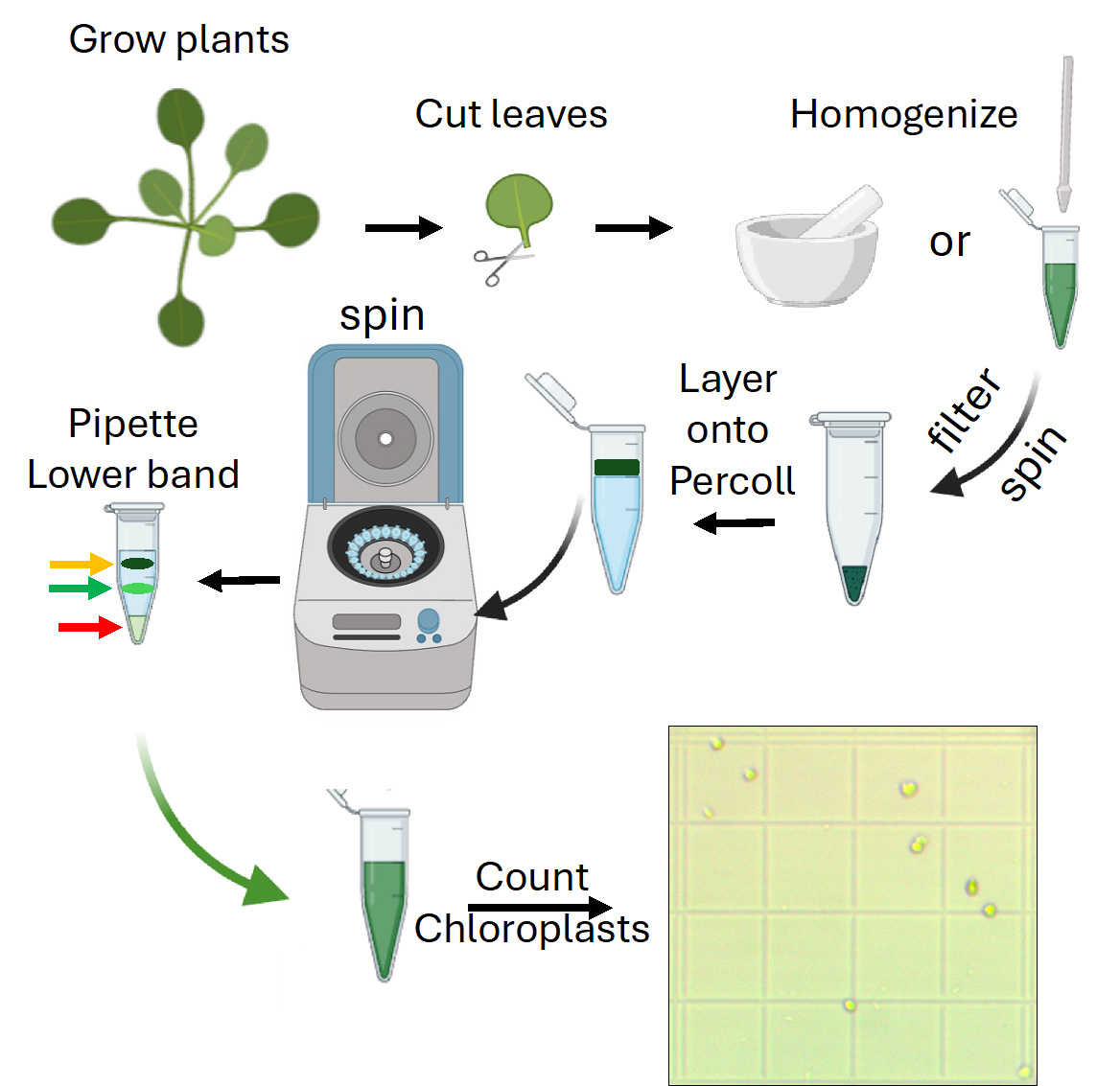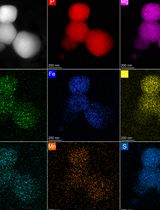- EN - English
- CN - 中文
Rapid Miniprep of Intact Chloroplasts from Arabidopsis thaliana Leaves
拟南芥叶片中完整叶绿体的快速小量提取
(*contributed equally to this work) 发布: 2025年05月20日第15卷第10期 DOI: 10.21769/BioProtoc.5313 浏览次数: 2178
评审: Shweta PanchalYu LiuDheeraj Singh RathoreAnonymous reviewer(s)
Abstract
Cell subfractionation is a common technique employed in many research laboratories to isolate organelles or intracellular compartments for the study of metabolism or biomolecule purification. While numerous protocols exist for isolating organelles, few are specifically designed for starting materials in the milligram range. Here, we present a detailed milligram-scale miniprep protocol for purifying intact chloroplasts from Arabidopsis thaliana leaves. This chloroplast miniprep procedure is suitable for applications such as confocal microscopy, western blotting, enzymatic assays, and other downstream analyses.
Key features
• This protocol condenses key aspects of existing methods and adapts them to the miniprep scale.
• Researchers can isolate purified chloroplasts within 1.5 h.
• This protocol requires standard laboratory equipment, such as microcentrifuges (ultracentrifuges are not required).
Keywords: Chloroplasts (叶绿体)Graphical overview

Background
Differential centrifugation has substantially enriched available toolkits in cell biology and biochemistry. For example, decades ago, Bensley and Hoerr successfully isolated mitochondria from guinea pig and rabbit liver tissue [1]; later, Chen and Lehninger refined such procedures in higher plants [2]. Around the same time, Walker developed a method for efficiently isolating chloroplasts using sorbitol as osmotic support, enabling successful carbon fixation studies [3]. Later, isopycnic centrifugation protocols allowed for the recovery of highly pure organelle preparations with good yields, albeit requiring substantial quantities of starting material (~100 g) [4]. While these experiments sparked research on isolated organelles, most protocols required starting material quantities in the gram range [5].
During the 1990s, the successful introduction of optimized procedures to isolate DNA, known as minipreps, standardized DNA isolation and manipulation in thousands of laboratories around the world. This allowed the rapid isolation of DNA from bacteria, filamentous microorganisms, and even plants [6–9]. These preparations are typically purchased as kits offering different isolation scales (i.e., minipreps, midipreps, and even maxipreps). Kits specifically designed to isolate various biological materials, including mitochondria, nuclei, or chloroplasts, are also available at different scales and costs. However, most of these kits are either expensive or difficult to obtain in several countries. An effective chloroplast isolation protocol should require minimal biological and laboratory materials. In addition, organelle isolation should be completed as quickly as possible to ensure functional chloroplasts for downstream applications.
The purpose of this protocol is to provide easy-to-follow instructions for isolating intact chloroplasts from leaves in an inexpensive manner, using standard equipment and materials. It requires only small amounts of starting biological material and has the potential for portability (i.e., in-field isolations). The isolated chloroplasts are suitable for western blotting, microscopy, and omics analyses.
Materials and reagents
Biological materials
1. Arabidopsis thaliana natural accession Col-0 (Columbia) (ABRC, CS22625)
Reagents
1. Agar (Sigma-Aldrich, catalog number: A1296-500G)
2. Tween 20 (Sigma-Aldrich, catalog number: P9416-100ML)
3. Commercial bleach solution containing 6% NaOCl
4. D-Mannitol (Sigma-Aldrich, catalog number: M1902-5KG)
5. EDTA (J. T. Baker, catalog number: 8993-01)
6. Hoagland solution (Sigma-Aldrich, catalog number: H2395-10L); use full-strength solution
7. KCl (1 M stock) (J. T. Baker, catalog number: 3040)
8. K2HPO4 (J. T. Baker, catalog number: 3252-01)
9. MgCl2 (2 M stock) (J. T. Baker, catalog number: 2444-01)
10. Miracle-Gro 8 and Miracle Gro perlite (The Scotts Miracle-Gro Company, model: 70752300)
11. Murashige and Skoog (MS) basal medium (Merck, catalog number: M5519)
12. Percoll (GE Healthcare, catalog number: 17-0891-02)
13. Sucrose (Sigma-Aldrich, catalog number: S7903-5KG)
14. Trizma base pH = 7.5 (1 M stock) (Sigma-Aldrich, catalog number: RDD008-1KG)
15. Sunshine Mix 3 substrate (Sungro Horticulture)
16. Anti-PsaB (Agrisera, catalog number: AS10 695)
17. Anti-Actin (Sigma-Aldrich, catalog number: A0480)
Solutions
1. Chloroplast isolation (CI) buffer (see Recipes)
Recipes
1. Chloroplast isolation (CI) buffer
| Reagent | Final concentration | Quantity or Volume |
|---|---|---|
| Sucrose | 400 mM | 27.4 g |
| MgCl2 | 5 mM | 0.5 mL |
| KCl | 10 mM | 2 mL |
| Trizma pH 7.5 | 20 mM | 4 mL |
| Milli-Q Water | Make up to 200 mL |
Laboratory supplies
1. Eppendorf tubes (Sigma-Aldrich, catalog number: EP022431021)
2. Pellet pestles (Sigma-Aldrich, catalog number: Z359947)
3. Microscope slides (Sigma-Aldrich, catalog number: CLS294875X25)
4. Pipettes (2–20 μL, 20–200 μL, and 100–1,000 μL)
5. Precision tweezers (Sigma-Aldrich, catalog number: Z680273)
6. Coverslips
7. Dissecting scissors (Merck, catalog number: Z265969)
8. Miracloth (Merck, catalog number: 475855)
Equipment
1. Autoclave
2. Epifluorescence or confocal microscope
3. Laminar flow hood for MS medium preparation
4. pH potentiometer
5. Vacuum pump
6. Plant incubation chamber (HERATherm, Thermo, catalog number: 50125590)
7. Lordem LED Grow Light (Lordem, catalog number: HL-0026)
8. Mini ceramic mortar and pestle (Sigma-Aldrich, catalog number: Z247464)
9. MC-24R refrigerated microcentrifuge (Benchmark Scientific, catalog number: C2417-R)
Procedure
文章信息
稿件历史记录
提交日期: Feb 20, 2025
接收日期: Apr 8, 2025
在线发布日期: Apr 30, 2025
出版日期: May 20, 2025
版权信息
© 2025 The Author(s); This is an open access article under the CC BY-NC license (https://creativecommons.org/licenses/by-nc/4.0/).
如何引用
Carranza-Correa, B. A., Dahlman-Cabrera, K. M. and Gutiérrez-Aguilar, M. (2025). Rapid Miniprep of Intact Chloroplasts from Arabidopsis thaliana Leaves. Bio-protocol 15(10): e5313. DOI: 10.21769/BioProtoc.5313.
分类
植物科学 > 植物细胞生物学 > 细胞器分离
细胞生物学 > 细胞器分离
您对这篇实验方法有问题吗?
在此处发布您的问题,我们将邀请本文作者来回答。同时,我们会将您的问题发布到Bio-protocol Exchange,以便寻求社区成员的帮助。
提问指南
+ 问题描述
写下详细的问题描述,包括所有有助于他人回答您问题的信息(例如实验过程、条件和相关图像等)。
Share
Bluesky
X
Copy link











